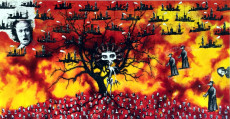
The specificities of charcoal

Charcoal is one of the oldest drawing tools. Simple to use, it has many advantages and great potential. Although it is a little difficult for beginners to handle, it takes a little practice to quickly become an essential tool. But what exactly is charcoal? Charcoal is a piece of wood that has been carbonised by burning without oxygen, in other words, like coal. Charcoal comes from the shrub of the same name: the European charcoal. It is an essential tool and is widely used in sketches, sketches and art drawings but not only.
History of charcoal
Charcoal dates back to the beginning of mankind when it was used by prehistoric man to draw on cave walls. Later, it was democratized but only as a simple sketching tool. Its development as a technique in its own right took place in the 1850s, at the same time as photography. At that time, artists were particularly interested in light and charcoal was the preferred tool for working with chiaroscuro. Charcoal was also popular with post-impressionist artists such as Georges Seurat.
Advantages of charcoal
Rather accessible, charcoal makes it possible to obtain very marked blacks and precise lines. It can be used to produce both fine and very broad strokes, depending on its use. Charcoal also allows for multiple effects, light/dark, shadows and details. There are several types of charcoal, more or less soft. A dry model will offer a light rendering while a soft model will offer blacker lines. Charcoal can be used on the tip for precise lines or applied flat across its width to fill in more space. Charcoal leaves a powder when applied. If there is an excess, a cloth or brush can be used to remove the excess. An eraser can be used if necessary. Some painters use charcoal to draw before painting. It allows for quick definition of light and shade and can be quickly erased if the result is not up to standard.
Advice on using charcoal
When drawing with charcoal, it is important to use thick paper that is not too smooth. It is best to work vertically to avoid dirtying the work with charcoal dust. However, it will be difficult to keep clean when using this tool. To cut the charcoal, a piece of sandpaper is recommended. A sharp point is needed to work on the details. A stump can also be used to get a more precise point than with the fingers. Once the work has been completed, a fixative should be applied as charcoal dust is very fragile and volatile. After use, the charcoal should be kept in an airtight box to avoid spreading its dust and to protect it, as it is a particularly brittle tool.
Examples of charcoal works available on ARTactif
To get a more precise idea of what can be done with charcoal, go to ARTactif and its more than 300,000 works listed. Since its creation, the objective of ARTactif is to help artists to make a name for themselves by presenting their artistic creations to the greatest number. You can thus find the work that corresponds to you in a few clicks. Thanks to an efficient search tab and numerous filters, you can refine your selection. By selecting the medium "charcoal", you will have a vast overview of works made with this tool. This is an opportunity to get to know new artists, to discover the possibilities of rendering and why not give you the desire to try it yourself.
Discover all the works made with charcoal by ARTactif, by clicking HERE.




































































